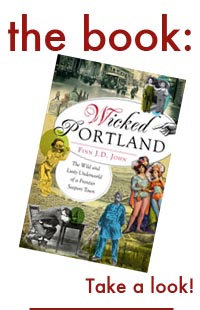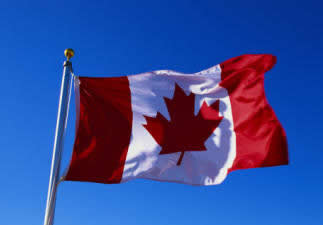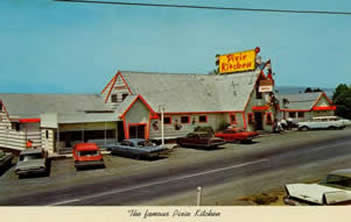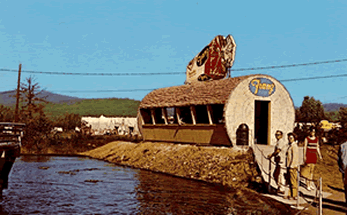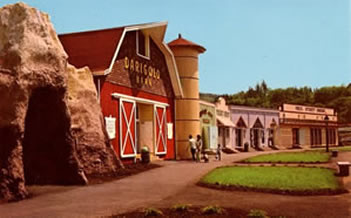Pixieland: Fleeting memories of a funky Oregon amusement park
Built in the late 1960s as a "fairy-tale history of Oregon," the amusement park lasted just a few years before slipping into receivership. Today, all that's left is a dilapidated guardshack.
EDITOR'S NOTE: A revised, updated and expanded version of this story was published in 2017 and is recommended in preference to this older one. To read it, click here.
This postcard image shows the Pixie Kitchen as
it appeared in the mid-1960s, when it was a popular
tourist attraction on the central Oregon coast. (For a
larger version, and many more great old images of
Pixieland, click here to see the Pixieland retrospective
at
www.pdxhistory.com.)
By Finn J.D. John — December 6, 2009
If you’ve ever spent a day on the Oregon Coast during the “off season,” you probably have a pretty good idea why Walt Disney didn’t decide to put Disneyland there.
But a little over 40 years ago, someone did launch a big, ambitious theme park on the Oregon Coast. It was called Pixieland. Some of you may actually remember it.
Pixieland was the brainchild of Jerry and Lu Parks, then the owners of one of the state’s most popular destination restaurants: The Pixie Kitchen in Lincoln City. The Pixie Kitchen had been there since the 1930s and was hugely popular. It had an entry full of fun-house mirrors, pictures of frolicking pixies painted on the walls and a “life-size” diorama of three pixies operating a little train in the back, outside the dining-area windows.
This image shows the interior of the Pixie Kitchen,
with the pixies and Little Toot visible out the
window behind them. (Mmm, martinis!) (For a
larger version, and many more great old images of
Pixieland, click here to see the Pixieland
retrospective
at
www.pdxhistory.com.)
The restaurant was so popular, in fact, that the owners were lulled into making a fateful decision: Using the elfin green-clad “Pixie” who served as the Kitchen’s mascot, they would create a theme park on Highway 18 just north of Lincoln City, near Otis.
In concept, Pixieland was to be a “fairy-tale history of Oregon,” with a log flume ride, a narrow-gauge railroad pulled by a steam engine called “Little Toot,” a frontier-like village full of little stores and amusements and an “Opera House” where Old West-style melodramas were staged.
The Parks put up $300,000 of their own, and two stock offerings were held -- both highly successful. Oregon businesses also stepped right up, and evidence of their involvement was everywhere, even to the point of outright campiness. At the log flume ride -- intended as a nod to Oregon’s timber industry -- spectators could relax in the “Franz Bread Rest Hut,” a giant fiberglass structure shaped like a hollow log with a huge loaf of balloon bread sticking out of the roof. In the “Main Street” part of the park stood the big red Darigold Barn Fountain and adjacent Cheese Cave, where a hungry or thirsty (and lactose-tolerant) visitor could get all sorts of dairy treats. And the Fischer Scone kiosk was topped with a mammoth Fiberglass hat -- a Scottish tam.
The Franz Bread Rest Hut overlooked the log flume
ride at Pixieland. For a larger picture, click here.
Oregon governor Tom McCall officially dedicated Pixieland on June 28, 1969, a couple years after Parks unveiled his plans. It was met with great excitement, and the park turned out to be very popular … in the summertime.
Whether because of the long rainy season, or the high cost of maintaining buildings at the coast, or for other reasons, Pixieland didn’t last long. Four years later, it closed for good, and the rides and features that could be auctioned off were.
Two years ago a reporter from the Oregonian went to the site and reported that very little remains -- just a tiny shack that once was a gate house. The marine climate at the Oregon Coast has almost completely reclaimed the site, which was largely built on wetlands anyway. Today, the site is part of the protected Salmon River estuary.
The Darigold barn and the improbable-looking
cheese cave next door were a popular part of
Pixieland ... at least, for those guests who weren't
lactose-intolerant. (For a
larger version of this
picture, and many more great old images of
Pixieland, click here to see the Pixieland
retrospective
at
www.pdxhistory.com.)
As for the Pixie Kitchen, it soldiered on into the mid-1980s, when it closed and the building was used for a nightclub. A fire damaged it heavily in the 1990s, and afterward the building was razed.
There is, by the way, a wonderful collection of Pixieland photos and some more details on its history at www.pdxhistory.com/html/pixieland.html.
(Sources: www.pdxhistory.com; Inara Verzemnieks, “Invisible Cities: Pixieland…,” The Oregonian, Jan. 22, 2008)
-30-

